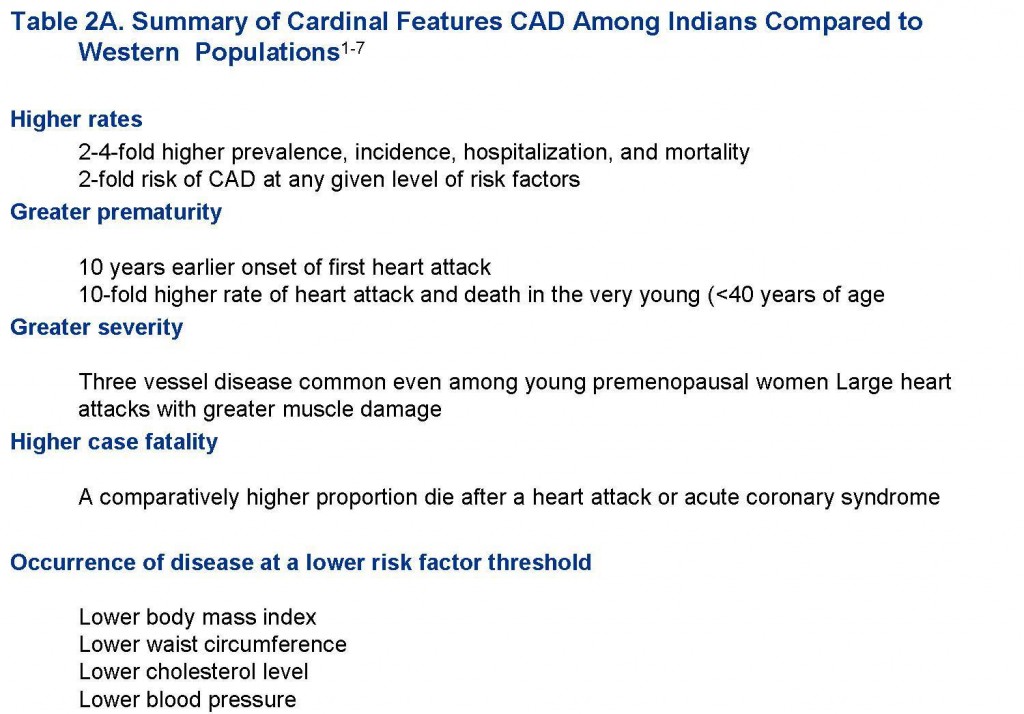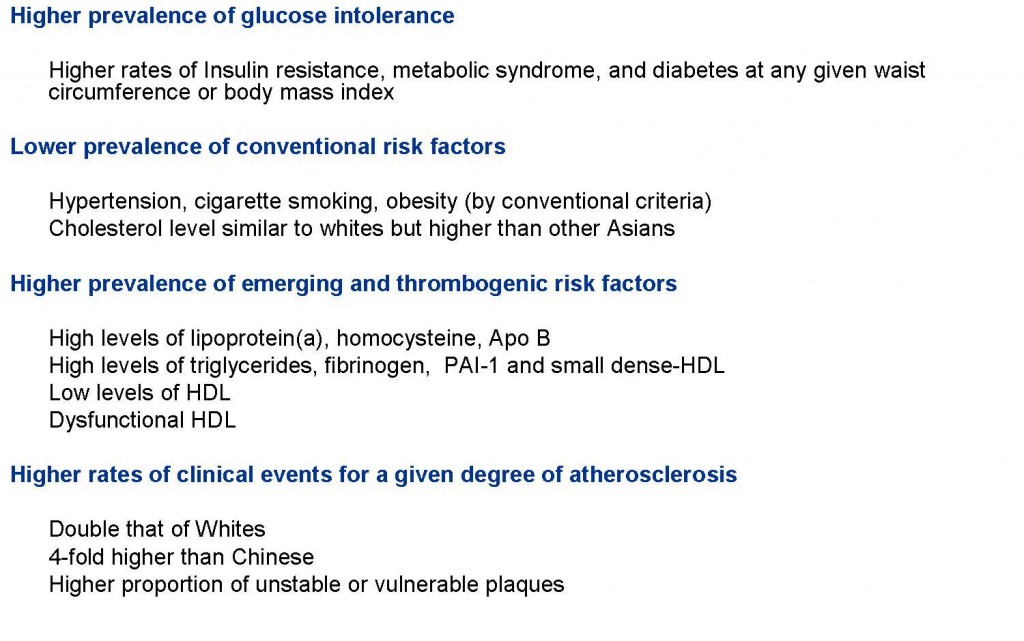Cardinal Features of CAD among Indians
- The cardinal features of CAD (coronary artery disease) in Asian Indians are extreme prematurity and severity leading to high mortality at a young age that is described as malignant heart disease.1-6
- About 25% of heart attacks in India occur under the age of 40 and 50% under the age of 50.13 One center reported a 47-fold increase in the incidence of first heart attack under the age of 40 during a 20 year period.14In an angiographic study in Malaysia, Asian Indians under 40 years of age had a 15-fold higher rate of CAD compared to Chinese and a 10-fold higher rate compared to Malays.12The excess risk of CAD in Asian Indians is much greater at younger ages.9 In the U.K, CAD mortality in Asian Indian men between the ages of 20-29 was 3.3 times that in Whites as opposed to 1.36 times in the overall age groups.10 Likewise in Singapore, compared with Chinese, CAD mortality in Asian Indian men between ages 30-39 is 12.5 times, but only three times in the 60-69 age group.11
- In general, heart attacks develop 5-10 years earlier in Asian Indians than in other populations, and its occurrence in patients under 40 is 5 to 10-fold higher.4, 15, 16
- Among CAD patients undergoing coronary angiogram, three-vessel disease is seen among half of all Asian Indians and one third of premenopausal women.17-19
- Unlike in Whites, CAD in young Asian Indians is known to be severe, extensive, and malignant. This is attributed to an accelerated atherosclerotic process that begins early in life and most likely mediated by lipoprotein(a).20 21
- For more information see prematurity, severity, and classification.
Sources
1. Enas EA. Why Indians are more susceptible to Coronary artery disease: Role of specific risk factors In: Chatterjee SS, ed. Update in Cardiology Hyderabad: Cardiology Society of India; 2007.
2. Enas EA. Why is there an epidemic of malignant CAD in young Indians? Asian J Clin Cardiol. 1998;1:43-59.
3. Enas EA, Mehta J. Malignant coronary artery disease in young Asian Indians: thoughts on pathogenesis, prevention, and therapy. Coronary Artery Disease in Asian Indians (CADI) Study. Clinical cardiology. Mar 1995;18(3):131-135.
4. Zimmerman FH, Cameron A, Fisher LD, Ng G. Myocardial infarction in young adults: angiographic characterization, risk factors and prognosis (Coronary Artery Surgery Study Registry). J Am Coll Cardiol. Sep 1995;26(3):654-661.
5. Sharma SN, Kaul U, Wasir HS, et al. Coronary arteriographic profile in young and old Indian patients with ischaemic heart disease: A comparative study. Indian heart journal. 1990;42(5):365-369.
6. Pahlajani DB, Chawla MH, Kapashi KA. Coronary artery disease pattern in the young. J Assoc Physicians India. 1989;37(5):312-314.
7. Vamadevan AS, Shah BR, Califf RM, Prabhakaran D. Cardiovascular research in India: a perspective. Am Heart J. Mar 2011;161(3):431-438.
8. Anand SS, Yusuf S, Vuksan V, et al. Differences in risk factors, atherosclerosis, and cardiovascular disease between ethnic groups in Canada: the Study of Health Assessment and Risk in Ethnic groups (SHARE). Lancet. 2000;356(9226):279-284.
9. Enas EA, Garg A, Davidson MA, Nair VM, Huet BA, Yusuf S. Coronary heart disease and its risk factors in first-generation immigrant Asian Indians to the United States of America. Indian Heart J. 1996;48(4):343-353.
10. Balarajan R. Ethnic differences in mortality from ischaemic heart disease and cerebrovascular disease in England and Wales. Bmj. Mar 9 1991;302(6776):560-564.
11. Hughes K, Yeo PP, Lun KC, et al. Cardiovascular diseases in Chinese, Malays, and Indians in Singapore. II. Differences in risk factor levels. J Epidemiol Community Health. Mar 1990;44(1):29-35.
12. Rajadurai J, Arokiasamy J, Pasamanickam K, Shatar A, Mei Lin O. Coronary artery disease in Asians. Aust N Z J Med. 1992;22(4):345-348.
13. Bahuleyan CG. Hospital data on coronary heart disease from North Kerala. In: Vijayaraghavan G, ed. Cardiovascular Disease Prevention: Trivandrum Medical College; 1996:54-59.
14. Mammi MV, Pavithran K, Abdu Rahiman P, Pisharody R, Sugathan K. Acute myocardial infarction in north Kerala–a 20 year hospital based study. Indian heart journal. 1991;43(2):93-96.
15. Hughes LO, Cruickshank JK, Wright J, Raftery E. Disturbances of insulin in British Asian and white men surviving myocardial infarction. Bmj. 1989;299(6698):537-541.
16. Negus B H, Willard JE, Glamann DB, et al. Coronary anatomy and prognosis of young, asymptomatic survivors of myocardial infarction. Am J Med. 1994;96(4):354-358.
17. Dave TH, Wasir HS, Prabhakaran D, et al. Profile of coronary artery disease in Indian women: Correlation of clinical, non invasive and coronary angiographic findings. Indian heart journal. 1991;43(1):25-29.
18. Enas EA. Lipoprotein(a) is an important genetic risk factor for coronary artery disease in Asian Indians. Am J Cardiol. 2001;88:201-202.
19. Enas EA, Mehta J. Malignant coronary artery disease in young Asian Indians: Thoughts on pathogenesis, prevention, and treatment. Clin Cardiol. 1995;18:131-135.
20. Enas EA, Chacko V, Senthilkumar A, Puthumana N, Mohan V. Elevated lipoprotein(a)–a genetic risk factor for premature vascular disease in people with and without standard risk factors: a review. Dis Mon. Jan 2006;52(1):5-50.
21. Bhalodkar NC, EA E. Malignant Coronary Artery Disease and the Asian Indian Paradox Proceedings of the 13th International Congress on Heart Disease Conference, New Trends in Research, Diagnosis, and Treatment 2007:157-164.



